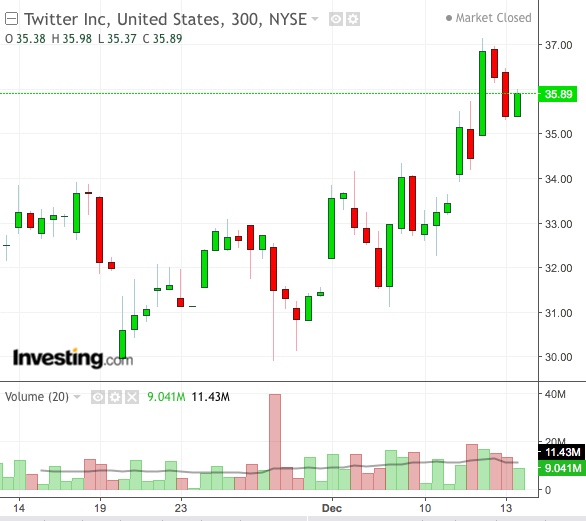It’s really hard to break the resolve of Twitter (NYSE:TWTR) bulls. Even in a market where many tech titans are crumbling, this social media stock is quietly continuing its upward journey.
In this quarter, which has seen massive declines in growth-oriented stocks, Twitter shares have surged nearly 20%. Its 6% gain on Dec. 12 helped push the month’s gains to 14%.

That strength has positioned the company to deliver the best returns of 2018 when compared to the FAANG group of top technology stocks that includes Amazon (NASDAQ:AMZN), Facebook (NASDAQ:FB), Netflix (NASDAQ:NFLX) and Apple (NASDAQ:AAPL).
If you didn’t follow the Twitter story this year, you might be wondering what is behind this stunning streak of strength and what makes Twitter a different player.
In our view, Twitter is playing smartly in this environment where regulators, politicians and the general public are scrutinizing social media companies after a series of data breaches and political manipulation over these platforms.
Twitter has provided investors visibility by adopting an open approach to problems within its network. CEO Jack Dorsey has been warning investors from this summer that his platform won’t see growth in its users as the company undertakes a massive cleanup operation, removing fake accounts and putting an end to hate speech.
In the past summer, the company informed investors that it had identified almost 10 million dubious accounts a week and is putting all accounts through a security check.
Strategy Is Paying Off
This openness, which initially caused a huge selloff in Twitter stock, was a different and riskier strategy than what Facebook pursued. According to a recent report in The New York Times, Facebook pursued a policy of denial and deflection and aggressively sought to shape public and political perception when it became clear that its platform is being manipulated by vested interests and foreign adversaries.
With its aggressive cleanup exercise, Twitter has also been successful in squeezing more revenue from advertisers, even as the user growth slowed during the past two quarters.
While Twitter suffered its steepest decline ever in its number of monthly active users worldwide in the third quarter, the company saw a significant jump in revenue from advertising, particularly in the U.S. Overall, third-quarter revenue climbed 29% to $758 million, most of it from ads and the largest increase since the first quarter of 2016.
As we highlighted in our September article, Twitter’s success in attracting ad dollars is largely the result of the company’s push to increase its video content. That’s resonating with advertisers very well. We believe this strategy, which is one of the main components of Dorsey’s turnaround plan, will continue to strengthen Twitter’s appeal. The video segment now accounts for more than half of Twitter's ad revenue.
Twitter's real-time highlights and video partnerships have positioned the company as a broadcast and communications network, making it complementary to all other forms of media, including TV. Twitter is also well positioned to benefit from the large shift in dollars toward mobile and native advertising.
These new areas of growth aren’t going to dry up as Twitter deploys more resources to monetize its huge user base and makes its platform more acceptable to regulators. Dorsey told analysts in October that cleaning up the platform ultimately helps drive user growth. He said:
“We continue to make really steady progress against some of the health initiatives that we’re seeing, most notably this quarter around suspicious sign-ups.”
Bottom Line
Twitter is well positioned to continue with its growth in 2019 and probably will be a net beneficiary if Facebook fails to put its house in order soon. In our view, at some point next year the decline in user growth will plateau once the company is done with its purging. That, combined with a sound business strategy, will be enough to push its stock even higher. We continue to remain bullish on Twitter’s long-term prospects.
